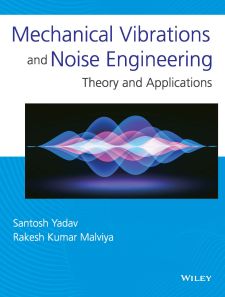Mechanical Vibrations and Noise Engineering: Theory and Applications
ISBN: 9788126599998
376 pages
Publication Year: 2021
For more information write to us at: acadmktg@wiley.com

Description
Mechanical Vibrations and Noise Engineering is a comprehensive textbook written for undergraduate and postgraduate students of mechanical, civil, aeronautical and automobile engineering. The book provides a unified presentation of the fundamental aspects of mechanical vibrations and noise engineering. Beginning with the analysis of undamped and damped free vibrations, the book explores the analytical methods to calculate the natural frequency, equivalent stiffness, time period, damping factor, damped natural frequency, logarithmic decrement, transmissibility, amplitude of force vibrations, critical speed of shaft, and frequency of torsional vibrations.
Chapter 1 Fundamental Aspects of Vibration
1.1 Introduction
1.2 Classification of Vibration
1.3 Significance of Vibration
1.4 Engineering Applications of Vibration
1.5 Terms Used in Vibration
1.6 Vector Representation of Harmonic Motion
1.7 Harmonic Analysis
1.8 Beats Phenomenon
1.9 Work Done by Harmonic Forces on Harmonic Motion
1.10 Non-harmonic Functions — Fourier Series Analysis
1.11 Elements of a Vibratory System
1.12 Lumped and Distributed Parameters
1.13 Equivalent Spring
1.14 Equivalent Dampers
Chapter 2 Undamped Free Vibrations
2.1 Introduction
2.2 Concepts of Undamped and Damped Free Vibrations, Undamped and Damped Forced Vibrations
2.3 Determination of Natural Frequency of Undamped Free Vibration
2.4 Effect of Mass of Spring on Natural Frequency
2.5 Derivation of Natural Frequency of Compound Pendulum
Chapter 3 Damped Free Vibrations
3.1 Introduction
3.2 Types of Damping
3.3 Differential Equation of Damped Free Vibration
3.4 Types of Damped System
3.5 Logarithmic Decrement (δ)
Chapter 4 Harmonically Excited Vibration
4.1 Introduction
4.2 Causes of Unbalance in a System
4.3 Equation of Motion of Forced Vibration
4.4 Vibration Isolation
4.5 Vibration Transmissibility
4.6 Methods of Measurement of Vibration
Chapter 5 Whirling Motion and Critical Speed
5.1 Introduction
5.2 Significance of Critical Speed
5.3 Critical Speed of a Shaft Carrying a Single Rotor (without Damping)
5.4 Critical Speed of a Shaft Carrying a Single Rotor (with Damping)
5.5 Secondary Critical Speed
5.6 Critical Speed of a Shaft Carrying Multiple Rotors (without Damping)
Chapter 6 System with Two Degrees of Freedom
6.1 Introduction
6.2 Vibrations of Undamped Two-Degree-of-Freedom Systems
6.3 Natural Frequency of Free Torsional Vibrations
6.4 Free Torsional Vibrations of Single-Rotor Systems
6.5 Free Torsional Vibrations of Two-Rotor Systems
6.6 Free Torsional Vibrations of Three-Rotor Systems
6.7 Torsionally Equivalent Shaft
6.8 Free Torsional Vibrations of Geared Systems
6.9 Coordinate Coupling
6.10 Vibration Absorber
6.11 Control of Vibration
Chapter 7 Multi-Degree-of-Freedom Systems
7.1 Introduction
7.2 Generalized Coordinates
7.3 Influence Coefficient
7.4 Methods to Determine Natural Frequency of a Multi-Degree-of- Freedom System
Chapter 8 Noise Engineering
8.1 Introduction
8.2 Characteristics of Sound Waves
8.3 Loudness and the Decibel Scale
8.4 Decibel Addition, Subtraction, and Averaging
8.5 Sound Power Level
8.6 The A-Weighting
8.7 Relationship between Sound Power
8.8 Relationship between Sound Pressure
8.9 Octave Bands (Frequency Bands)
Chapter 9 Noise: Isolation and Control Engineering
9.1 Introduction
9.2 How We Hear
9.3 Hearing Loss
9.4 Effects of Excessive Occupational Noise Exposure
9.5 Noise Exposure Controls: Overview
9.6 Noise Control Engineering: Concepts and Options
9.7 Administrative Controls
9.8 Personal Protective Equipment (Hearing Protection)
9.9 Statutory Provisions of Noise Pollution
Exercises
Multiple Choice Questions
Bibliography
Index

